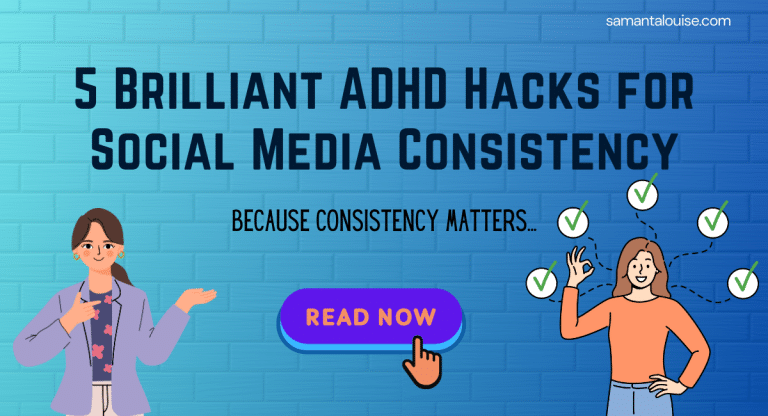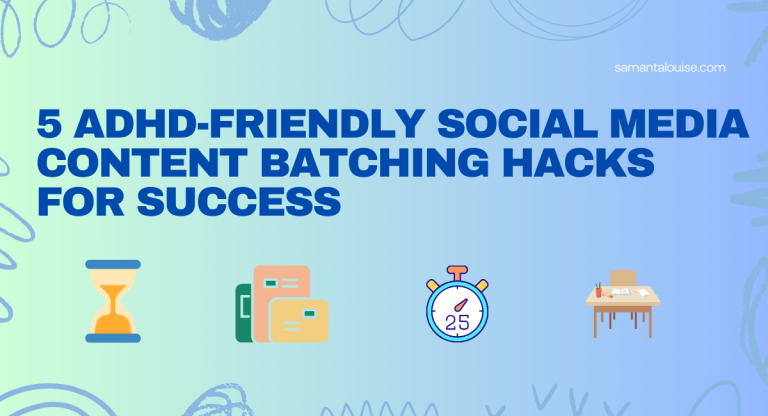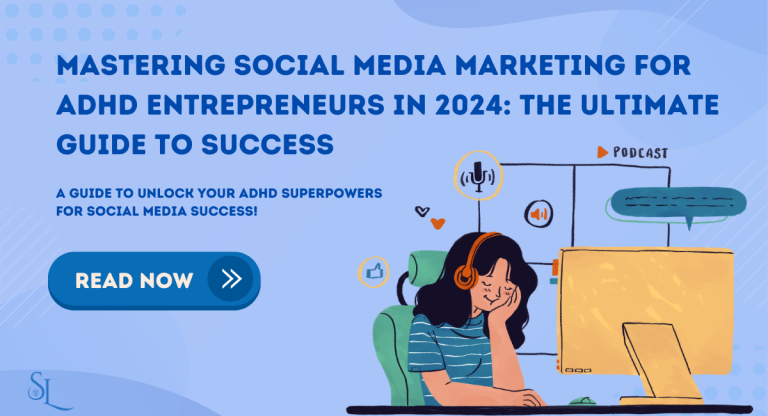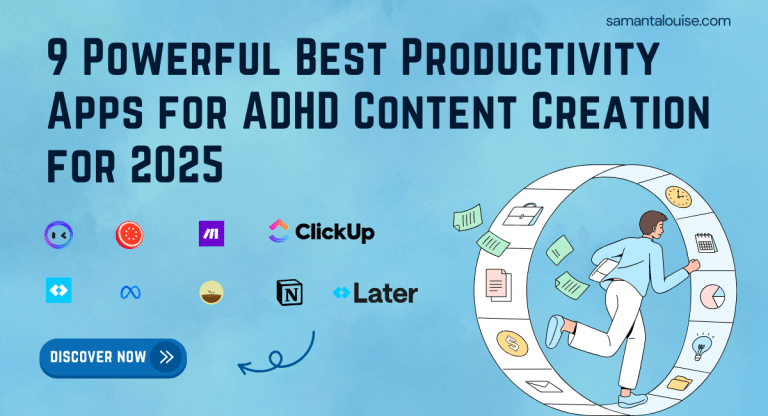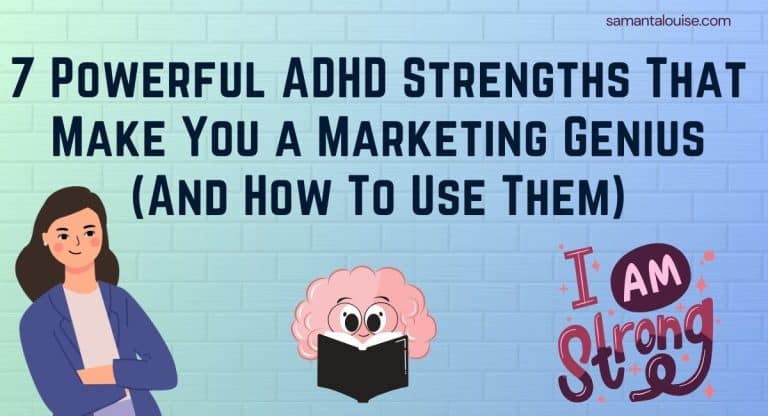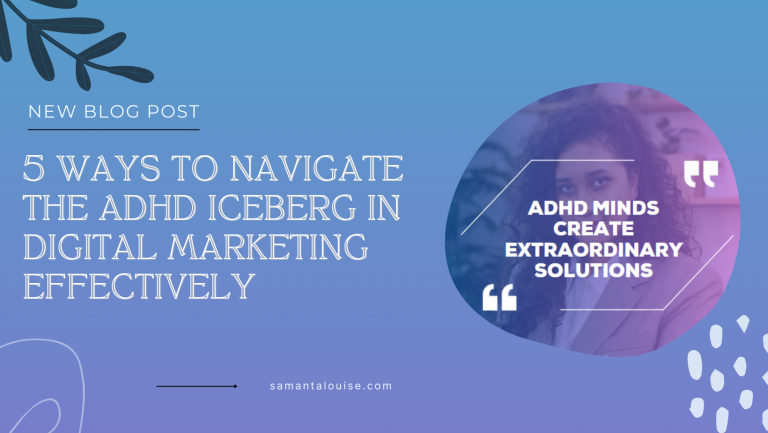5 Quick Tips To Stop ADHD Paralysis in Social Media Marketing
Ever stared at your content calendar, dozens of notifications blinking across multiple platforms, client messages piling up and next week’s content overdue but you cannot move? You cannot even decide where to start. This is what ADHD paralysis looks like… Your brain feels like it’s buffering endlessly.
ADHD executive dysfunction in social media marketing is more common than you think. And not understanding it makes it harder to navigate the social media marketing world. The first step towards success starts by recognizing what ADHD is exactly like in the context of social media productivity. It is an industry that never sleeps and constantly changes.
When a social media marketer with ADHD becomes overwhelmed by the constant stream of digital demands, real-time engagement needs, and creative pressures, their brain can essentially “freeze.” This isn’t just ordinary procrastination – it’s a complete shutdown of executive functioning skills in response to the unique digital marketing challenges of managing multiple platforms, creating engaging content, and measuring performance metrics.
ADHD-friendly workflows and productivity hacks for ADHD can make a significant difference in managing these challenges. In this guide, we’ll explore how ADHD paralysis manifests in social media marketing and how to use ADHD coping mechanisms to turn our ADHD traits into natural strengths in our job.
I will share five quick tips you can start implementing today to overcome ADHD task initiation difficulties and minimise the impact of ADHD paralysis.
Understanding ADHD Paralysis: What It Is and Why It Happens
As a digital marketer with ADHD, I’ve battled with ADHD executive dysfunction for years. It is like your brain hits an invisible wall even when you desperately want to move forward. It is a highly frustrating state where you literally cannot start or switch tasks, even when you know what needs to be done.
I once sat at my desk for three hours, staring at a blank document, fully aware I needed to write a simple social media post (something that I have done a thousand times) but unable to type a single word. This is a classic example of content creation blocks that many social media marketers with ADHD face.
What is the difference between procrastination and ADHD paralysis?
ADHD paralysis is when you are stuck, even though you want to act. Your brain feels frozen and often involves anxiety and a feeling of overwhelm whereas procrastination is more like choosing to delay a task because you prefer to.
According to Dr. Rusell Barkely, a leading ADHD researcher, ADHD paralysis is related to executive function deficits that lead to difficulties in task initiation, action selection, self-regulation and working memory. Research shows that ADHD involves executive function deficits and differences in prefrontal cortex activity and dopamine pathways, which can affect task initiation and follow-through.
On the other hand, procrastination is defined as voluntarily delaying an intended course of action and is categorized as conscious decision-making. While it may appear similar externally to ADHD task paralysis, there are some distinctive neurobiological differences in the way the brain works for both cases.
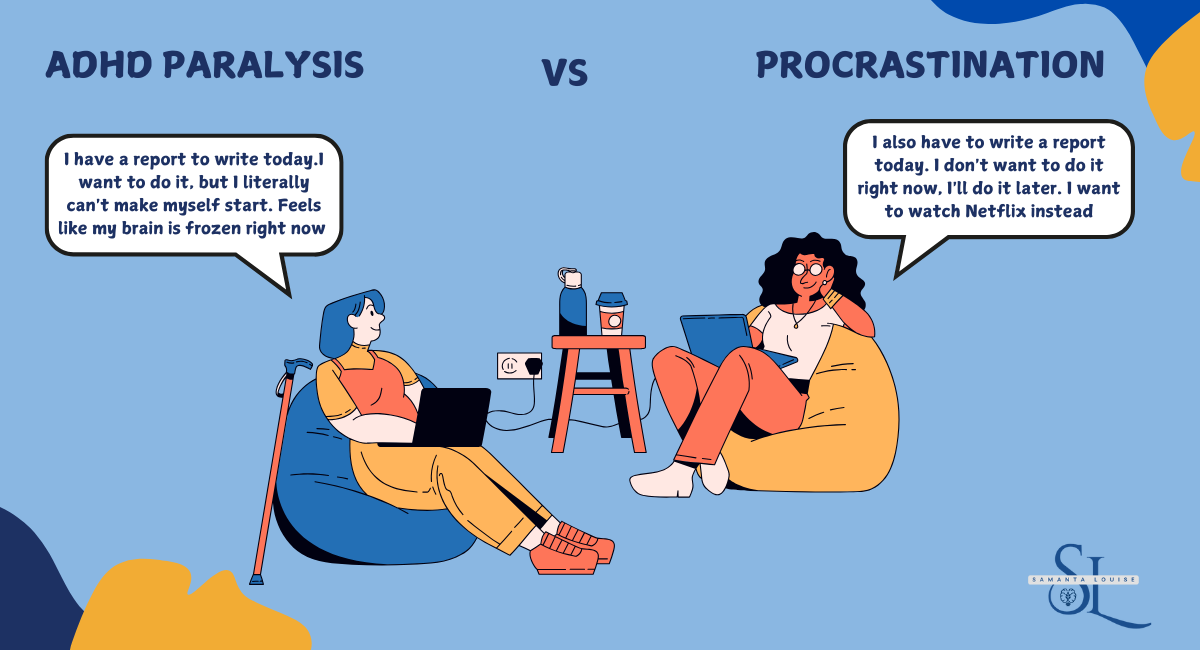
Recognizing the Symptoms of ADHD Paralysis in Your Social Media Workflow
At first, I thought that my ADHD task paralysis was just sheer procrastination which led to me hating myself for not being productive enough in my work but later on, as I learned more about ADHD symptoms and common challenges, I realised that what I was experiencing was ADHD executive dysfunction aka adhd paralysis.
Trust me, learning to spot these symptoms early can be a total game-changer for your social media productivity. You can implement the right strategies to overcome this challenge and not be penalised by it.
Inability to start or complete social media marketing tasks
Do you know that feeling of having multiple content ideas buzzing in your head but can’t seem to start creating any one of them? That’s classic task initiation paralysis. In content creation, ADHD task paralysis appears in some pretty sneaky ways. Sometimes it can be starting a new task or finishing an almost-done task such as publishing content. Even though everything might be ready or clear in your head, you can’t just move to start or complete the task.
In community management, you might find yourself:
- Reading the same comment 15 times before responding
- Opening and closing the DM tab repeatedly without actually answering messages
- Switching between multiple conversations but completing none
- Getting overwhelmed by notification numbers (even small ones)
How to identify your personal triggers?
Most people do not talk about the emotional impact of this common ADHD challenge. It is not just about productivity, it can mess with your head and make you feel like a failure or overwhelmed by pending work. So let’s get practical about identifying your personal triggers.
The easiest way to do this is to write about it. I keep a notepad just to record and jot down the following:
- The specific task I’m stuck on
- Time of day
- Current stress level (1-10)
- Environmental factors (noise, interruptions, etc.)
- Last time I took a break
After tracking this for some time, I discovered patterns. For example, my task paralysis would peak mostly in the afternoon (especially if I have skipped lunch) and when juggling multiple tasks. This knowledge has been invaluable in restructuring my ADHD-friendly workflow.
ADHD task paralysis is not a character flaw, but a genuine executive functioning challenge that affects people with ADHD. Your brain is not being stubborn; it is struggling with task initiation and decision-making processes. So you need to be compassionate and use ADHD coping mechanisms to work around it.
Exploring Clinically Recognized Types of ADHD Paralysis Affecting Social Media Marketers
Before we jump into these powerful tips to help you overcome ADHD task paralysis, it is important to have a look at the types of ADHD paralysis that might affect your social media marketing career.
Choice Paralysis
This occurs when the ADHD brain becomes overwhelmed by options and can’t make decisions. In social media marketing, this might look like: •
- Being unable to choose between multiple content ideas for a campaign •
- Getting stuck deciding which platform to prioritize
- Freezing up when selecting visual elements from a brand kit
- Being overwhelmed by analytics tools and which metrics to focus on
ADHD Task Initiation Paralysis
This is the inability to start a task, even when you understand what needs to be done. In social media marketing, this commonly appears as:
- Knowing you need to create content but being unable to open the scheduling tool
- Having a clear brief but struggling to write the first word of copy
- Being unable to begin monthly reporting even with all data available
- Postponing client communications despite having the information ready
ADHD Mental Analysis Paralysis
This involves getting stuck in overthinking and mental preparation without taking action. For social media marketers, this might mean:
- Endlessly researching hashtag strategies without implementing any
- Over-analyzing competitor content without creating your own
- Repeatedly reviewing engagement patterns without making content adjustments
- Spending excessive time planning content calendars but never executing
Identifying ADHD Choice Paralysis, ADHD Task Initiation Paralysis and ADHD Mental Paralysis In Your Daily Life
Choice paralysis is a classic example of ADHD and decision-making difficulties. Last week, I spent three hours trying to decide between two nearly identical filters for a client’s Instagram post. The difference was barely noticeable, but my brain couldn’t move past it. Pro tip: Set a timer for decision-making tasks. When it dings, you pick whatever option feels right at that moment and move on.
Task initiation paralysis is perhaps the most frustrating manifestation of ADHD task initiation difficulties. I once sat at my desk for an entire morning, fully aware that I needed to start a Facebook ad campaign, but completely unable to take the first step. Breaking tasks into ridiculously small chunks can help overcome this.
Mental analysis paralysis is where ADHD and perfectionism often intersect. I once spent an entire week tweaking a single Twitter thread, convinced it wasn’t quite perfect yet. Meanwhile, the optimal posting time came and went. You must have a “good enough” criteria for all your projects.
Each type of paralysis has distinct characteristics and requires specific management strategies, but they all stem from the same ADHD-related executive function challenges. Understanding these official categories helps in identifying and addressing them more effectively in our professional work.
5 Powerful Tips for Overcoming ADHD Paralysis in Social Media Marketing
Let me share some life-changing tips I’ve discovered over the years of doing social media marketing with ADHD. These aren’t just theoretical tips—they are practical tips I implement in my daily life as a digital marketer. They have helped me become more productive and diminish the impact of ADHD task paralysis in my social media marketing journey.
Before we jump into these tips, I want to clarify that these tips will not fix your ADHD. But they can help you overcome some of the challenges we face every day. And these tips need to be adapted to the type of ADHD task paralysis you are experiencing. I have included recommendations that have worked for me at the end of each section.

1. The Pomodoro Technique for Executing Digital Marketing Tasks
The Pomodoro Technique transformed how I handle social media tasks with my ADHD brain. Through years of trial and error, I’ve perfected my Pomodoro approach for social media work.
It is a simple time-blocking strategy that involves working for a set time, usually 25 minutes (called a Pomodoro) and then taking a 5-minute break between each Pomodoro session. You can dictate the rules by deciding on the number of Pomodoros you want to do and how long is your break after each session.
I start each session by setting up my workspace: notifications off, the Pomodoro timer app ready, and a clear task list. The key is to be ridiculously specific about what you’ll accomplish in each 25-minute block. Instead of “work on social media,” I write “write 3 Instagram captions for the wellness campaign.”
During each break, I do something physical – stretching, a quick walking session, or even just standing up and shaking it out. This helps reset my brain and prevents that zombie-like state we can fall into when staring at social feeds for too long.
Pro tip: Keep a “brain dump” notepad nearby. When random thoughts pop up during your Pomodoro (like remembering you need to respond to that client email), jot them down quickly and get back to focus. This prevents those thoughts from derailing your session.
This technique is best when I experience task initiation paralysis as it helps me break down large projects into short working sessions with planned work and a checklist.
2. Task Chunking To Break Down Big Tasks Into Small Ones
Task chunking is taking a big task (like managing Instagram) and cutting it into smaller, bite-sized pieces that are easier to handle. Think of task chunking like eating a large pizza. Instead of trying to eat the whole pizza at once (which would be impossible and overwhelming!), you cut it into smaller, manageable slices.
Here’s my exact process for breaking down a typical social media workflow:
Step 1: Identify a big task you need to complete (one-time or recurring)
Step 2: List down the steps you need to take to complete the task in the order
Step 3: Identify which steps can be completed independently of each other or without following a specific order
Step 4: List down which independent steps require the most effort and energy from you
Step 5: Plan each step and turn them into sub-tasks to be completed
Step 6: Assign a specific time to complete each sub-task and break that into Pomodoros
Here’s an example of my content creation process broken down into chunks:
- Research & Inspiration (30 mins)
- Content Theme Planning/Reels Filming (20 mins)
- Video editing (30 mins)
- Caption Writing (25 mins per platform)
- Image Creation/Selection (25 mins per platform)
- Hashtag Research (15 mins)
This method works best when experiencing task initiation paralysis and choice paralysis because you can break down a large task into smaller, more manageable chunks which makes it less intimidating to get started. In addition, you already took decisions in advance of what needs to be done and have less friction in deciding what to do.
3. Body-Doubling For Motivation and Accountability
As odd as this may sound, I discovered this technique during the pandemic. Social media marketing is mostly a remote job and sometimes, being on your own does not help as it encourages you to be complacent and not take action. At least, that’s how I felt.
The concept is simple: having someone present (even virtually) while you work can help activate your brain’s focus mechanisms. It’s like having a workout buddy but for productivity.
During the pandemic, I came across a lot of Live YouTube videos of people working or studying with Pomodoro timers at the top of the screen with some white noise (natural sounds like rain, fireplace, etc..) in the background.
After the pandemic, I found myself a work partner. Now, I have someone who is physically present in the room with me and is also working. We start each session by briefly sharing our goals for the day. On the days, my work buddy is not available physically, we do a huddle on Slack and then work quietly with cameras on.
The visual accountability makes a huge difference – it’s harder to fall into the scroll hole when someone else can see your screen. Here are some virtual body doubling options you can explore if you do not know anyone:
- Focusmate (great for structured sessions)
- Discord communities for social media managers
- Zoom sessions with industry colleagues
- YouTube “Study With Me” videos (when live partner
This method is excellent for overcoming adhd task initiation paralysis as it motivates you to work alongside your work partner which also creates a sense of accountability that can motivate you to start tasks.
4. Mindfulness and Grounding Practices For Overcoming Social Media Overwhelm
Mindfulness practices have been around for ages and have grown increasingly popular over the years. They have been crucial in managing the overwhelming aspects of social media work with ADHD. When metrics, notifications, and deadlines start spinning in your head, these techniques can help you regain focus.
Many researchers agree that mindfulness practices are highly beneficial for the ADHD brain by improving attention, reducing hyperactivity and impulsivity, enhancing executive functioning and reducing overall stress levels. Here are some little things I implement daily:
- Box breathing between tasks
- Quick desk stretches
- Screen brightness adjustments
- Regular hydration checks
- Gratitude sessions
- Mindfulness exercises using the Balance App
I’ve found that implementing these practices before starting challenging social media tasks helps a lot in calming and preparing me for the work. It’s not about being perfectly zen – it’s about maintaining enough mental clarity to make good decisions and keep moving forward.
You can develop more ADHD-friendly workflows and improve your overall social media productivity by implementing these strategies. These techniques address various aspects of ADHD executive dysfunction, from task initiation to time management and decision-making.
5. The 2-Minute Rule To Get Started With Pending Tasks
This is the simplest tip, and yet so powerful to reduce task initiation difficulties in social media management. The principle is simple: if a task takes less than two minutes, do it immediately. If a larger task feels overwhelming, find a two-minute starting point.
Here’s how I apply this to social media tasks:
- Responding to one comment
- Writing one social media caption
- Scheduling one post
- Researching three hashtags
- Saving one piece of inspiration
The beauty of this approach is that it often creates a “productivity snowball.” What starts as a two-minute task frequently turns into a productive hour because starting is usually the hardest part. I remember one day when I told myself I’d just write one Instagram caption – two hours later, I had completed content for the entire week.
Bonus Tips: Essential Tips For Dealing With ADHD Paralysis
It is not easy to navigate the social media marketing world with ADHD, especially when ADHD task paralysis keeps banging on your door. But here are some extra tips you should consider implementing to optimise your workflow:
1. Create an ADHD-friendly social media marketing environment
The physical environment is crucial for an ADHD brain. Here’s my tested setup:
- Dual monitors (one for primary work, one for reference materials)
- Noise-canceling headphones (game-changer for focus)
- Clean desk policy (only today’s essential items visible)
- Natural lighting (positioned desk near window)
- Temperature control (slightly cool keeps me alert)
- Standing desk option (movement helps processing)
- White noise machine (blocks irregular office sounds)
2. Use AI and other social media tools to make things easier for you
I always say this: AI is not here to steal your jobs but to help you do better and ease your burden. I have compiled a list of the 19 best social media tools I have used in my career as a digital marketer that have made a difference.
In addition to this, I have made an exceptional list of the 3 best social media automation tools I am currently using for more digital marketing productivity.
3. Do not hesitate to get professional help when things get out of control
Dealing with ADHD on your own might be overwhelming and impossible in some cases, which is why you should always seek appropriate professional help when needed. You should join support networks whose aim is to guide, help and understand you in your journey.
Getting help is not something to be ashamed of. If you still feel not so confident to talk to someone in person, there are online platforms with resourceful ADHD professionals you can talk to.
Next steps
By implementing these strategies, you can create an environment that supports your ADHD brain while enhancing your social media productivity.
This approach addresses various aspects of ADHD executive dysfunction, from task initiation to time management and decision-making. With practice and patience, you can develop a workflow that not only accommodates your ADHD but also leverages your unique strengths as a neurodivergent marketer.
If you would like to have free monthly resources such as life planners and ebooks on organic marketing, you can join my newsletter by clicking on the button in the main menu.

